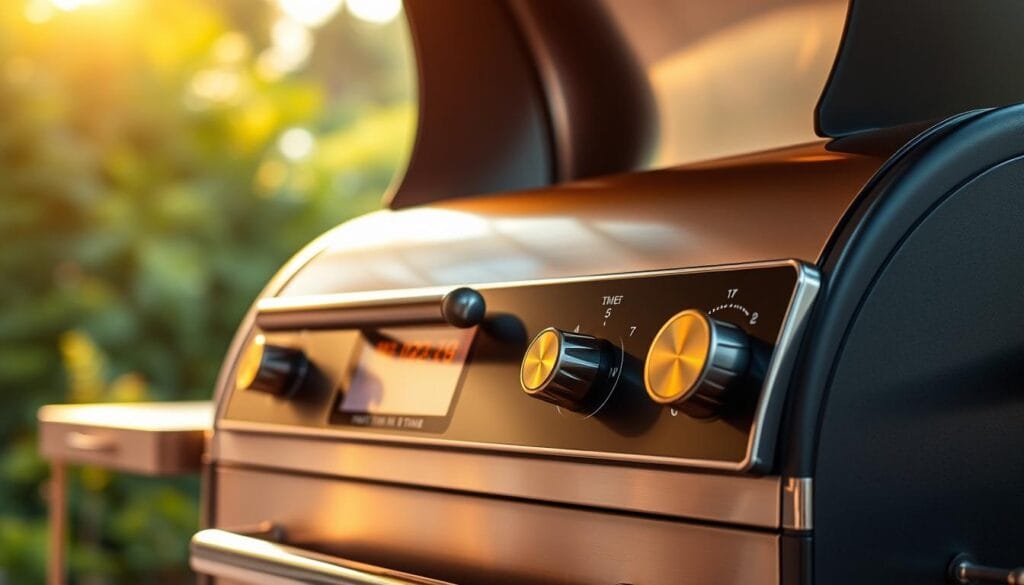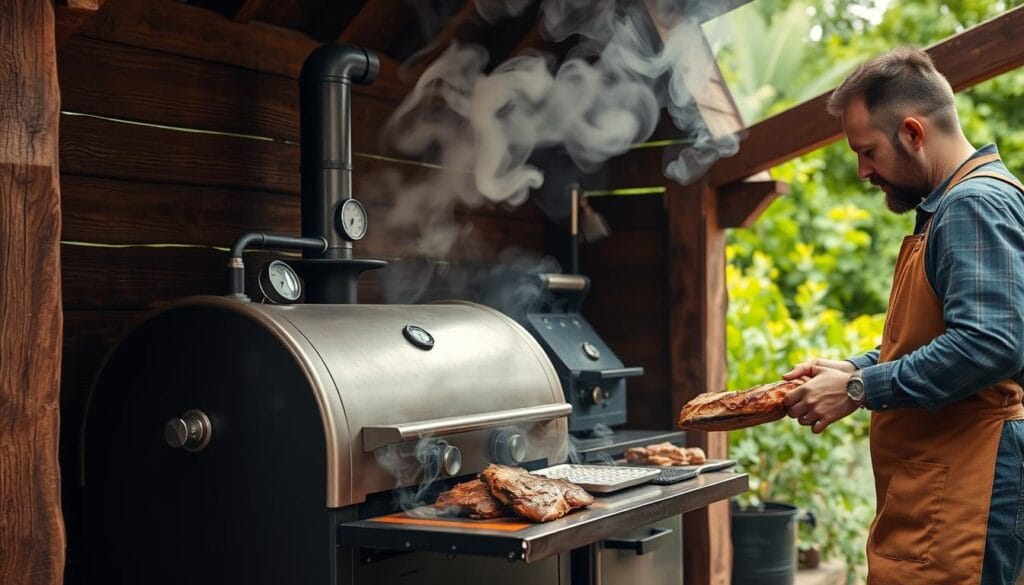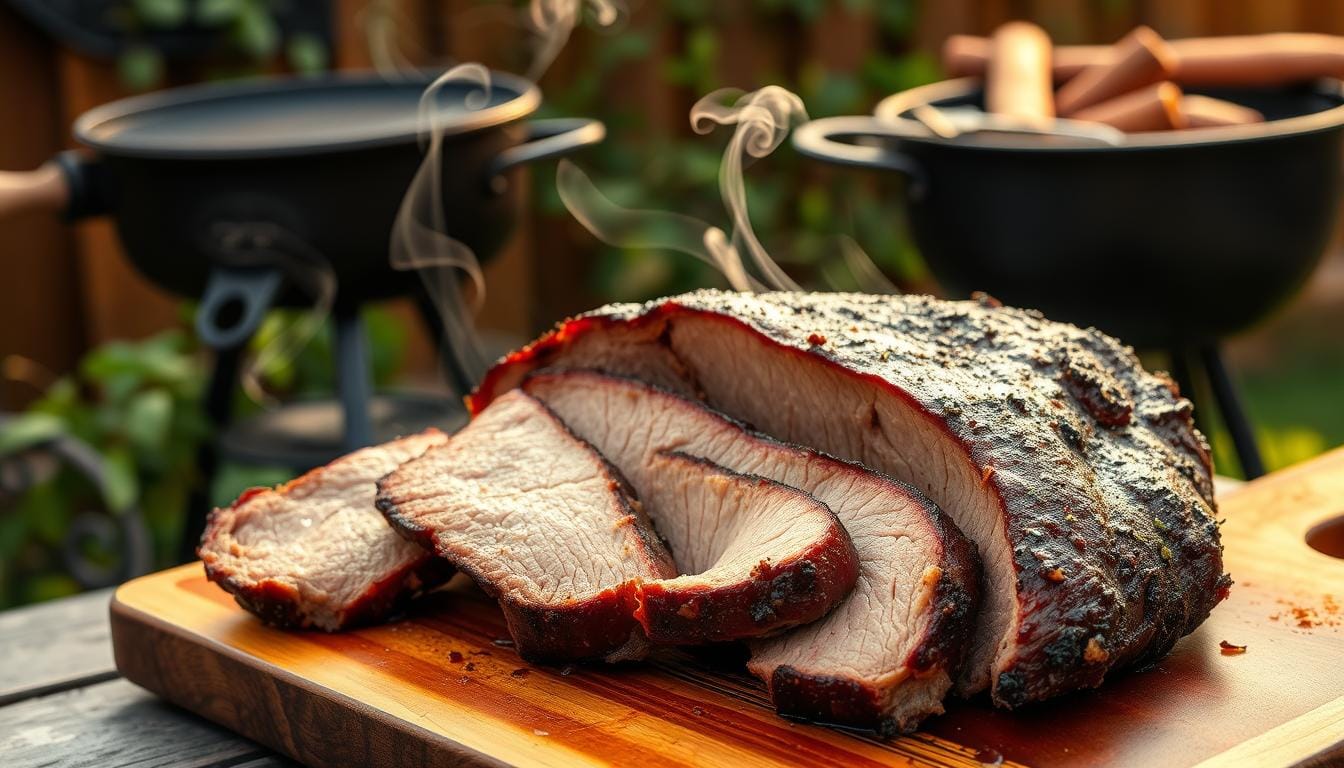Every pitmaster knows the magic of a perfectly smoked beef brisket. The anticipation grows as you slice through the dark, crusty exterior. Then, you reveal a tender, juicy interior that shows hours of patient cooking.
Smoked brisket recipes are more than cooking meat; they’re about creating an experience. Whether you’re a backyard BBQ fan or a serious smoker, mastering beef brisket takes skill, passion, and a desire to learn.
This guide will help you turn your brisket into a legendary dish. You’ll learn how to select the right cut and understand temperature nuances. Get ready to create mouthwatering smoked brisket that will have everyone asking for seconds.
Table of Contents
Understanding Beef Brisket: Cuts and Quality Selection
Choosing the right beef brisket is key for a great barbecue. Whether you’re grilling at home or competing, knowing about brisket can make your dishes better.
When picking a beef brisket, several things matter for its quality and how it smokes. Only 3% of cattle get a Prime grade. These cuts are special for your barbecue rubs and smoking.
Prime vs Choice vs Select Grades
Beef brisket grades affect your dish’s taste. Here’s a look at the USDA grading system:
| Grade | Marbling | Price | Recommended Use |
|---|---|---|---|
| Prime | Extensive | Highest | Professional BBQ, Special Occasions |
| Choice | Moderate | Mid-range | Home Smoking, Regular BBQ |
| Select | Minimal | Lowest | Budget Cooking |
Point Cut vs Flat Cut Differences
Knowing about brisket cuts helps pick the best meat for your rubs:
- Point Cut: Fattier, more flavorful
- Flat Cut: Leaner, more uniform
How to Choose the Perfect Brisket Size
“The ideal weight for a whole brisket is between 16 and 17 pounds.” – BBQ Experts
Here are tips for picking the right beef brisket:
- Look for a fat cap thickness of ¼ inch
- Ensure the flat is at least 1 inch thick
- Check for white, clean fat
- Avoid briskets with brown spots
By knowing these selection tips, you’ll find a top-notch beef brisket. It will surely impress at your next barbecue.
Essential Equipment and Tools for Smoking Brisket
Smoking the perfect brisket is not just about skill. You also need the right equipment. Whether you’re using a pellet grill, offset smoker, or electric smoker, the right tools are key to success.
- High-quality smoker
- Digital meat thermometer
- Wood smoking chips
- Heavy-duty gloves
- Spray bottle for basting
- Large cutting board
Choosing the right smoker is vital. Pellet grills offer consistent temperature control, while offset smokers provide traditional smoking experiences. Electric smokers are great for beginners who want predictable results.
| Equipment | Purpose | Recommended Brand |
|---|---|---|
| Digital Thermometer | Temperature Monitoring | Thermoworks ThermoPop |
| Smoker | Cooking Platform | Traeger Pellet Grill |
| Wood Chips | Flavor Enhancement | Hickory or Oak Varieties |
“The right tools transform good cooking into great barbecue.” – BBQ Pitmaster
Investing in quality tools is crucial. Your wood smoking chips and thermometer can make a big difference. Good equipment helps keep temperatures steady and brings out those deep, smoky flavors every pitmaster loves.
Preparing Your Brisket for Smoking
Getting your brisket ready for smoking is key to a great barbecue. It involves trimming, seasoning, and boosting flavor. These steps are crucial for success.
Smoking a perfect brisket begins with the right cut and careful prep. Your aim is to make a flavorful, tender piece of meat. This will wow even the pickiest barbecue fans.
Proper Trimming Techniques
Trimming your brisket needs precision and patience. Here’s how to get it right:
- Position the brisket with the fat side down on a spacious cutting board.
- Remove silver skin and excess fat from the flat end
- Square the edges for even cooking
- Trim the fat cap to approximately 1/4 inch thickness
Dry Rub Application Methods
Barbecue rubs are key for a tasty crust and better meat flavor. Here’s how to apply them:
- Ensure the brisket surface is completely dry
- Apply a generous and even coating of dry rub
- Massage the rub into the meat thoroughly
- Let the seasoned brisket rest for at least 4 hours
Brisket Marinade Options and Timing
Some prefer dry rubs, but a brisket marinade can add amazing flavor. Here are marinade tips:
- Choose marinades with complementary flavor profiles
- Marinate for 12-24 hours before smoking
- Pat the meat dry before applying barbecue rubs
- Avoid overly acidic marinades that can break down meat texture
“Great brisket starts with the preparation, not just the cooking.”
By using these prep techniques, you’ll create a delicious smoked brisket. It will be the star of any barbecue event.
Best Smoked Brisket Recipes for Different Smokers
Mastering smoked brisket recipes means knowing how different smokers work. Whether you’re using a Traeger, offset smoker, or electric smoker, each one adds its own flavor to your barbecue.
Choosing the right smoker is crucial for your brisket’s taste and texture. Here are some top recipes for various smoker types:
- Traeger Pellet Grill Brisket
- Offset Smoker Texas-Style Brisket
- Electric Smoker Tender Brisket
- Kettle Grill Smoked Brisket
For each smoker, keeping a steady temperature is essential. Try to keep the temperature between 225-250°F. Cooking time is about 1.5 to 2 hours per pound of meat.
| Smoker Type | Cooking Time | Recommended Temperature |
|---|---|---|
| Traeger Pellet Grill | 12-14 hours | 225°F |
| Offset Smoker | 12-16 hours | 235°F |
| Electric Smoker | 10-12 hours | 240°F |
| Kettle Grill | 8-10 hours | 250°F |
“The secret to great smoked brisket isn’t just the smoker, it’s the passion you bring to cooking.” – BBQ Pitmaster
The perfect brisket is tender and has an internal temperature of 195-203°F. Always check with a meat thermometer. Take the brisket off the heat when it hits this temperature.
Wood Selection and Smoking Techniques
Choosing the right smoking wood can make your brisket amazing. Knowing the flavors of different wood chips is key for a great BBQ.
The wood you pick greatly affects your brisket’s taste. Each wood type adds its own flavor, making your meat taste complex and exciting.
Popular Wood Types and Flavor Profiles
- Oak: A pitmaster’s favorite with medium to strong flavor balance
- Hickory: Rich, bacon-like taste that requires careful application
- Pecan: Offers subtle sweetness complementing savory brisket flavors
- Fruitwoods: Apple, cherry, and peach provide light, nuanced smoke
| Wood Type | Flavor Intensity | Best Use |
|---|---|---|
| Oak | Medium | Long smoking sessions |
| Hickory | Strong | Sparingly in blends |
| Pecan | Mild to Medium | Balanced flavor profiles |
| Fruitwoods | Light | Subtle flavor enhancement |
Temperature Control Strategies
Keeping the temperature steady is crucial for perfect brisket. Start at 180°F, then raise to 225°F. Cook for about 1.5 hours per pound, aiming for 185°F inside before resting.
Smoke Ring Development
“The smoke ring is the pitmaster’s signature – a testament to skill and patience.” – BBQ Expert
To get a perfect smoke ring, you need to know how wood chips work with meat. The pink layer forms early, showing off the smoker’s skill.
The Art of Temperature Management

Mastering temperature management is key for meat smoker recipes, especially for slow cooking like smoking brisket. Your success relies on keeping the heat just right throughout cooking.
Smoking temperatures usually fall between 225°F and 275°F. Most pitmasters aim for 240-250°F. Knowing these details can make your brisket go from good to great.
“Temperature control is the secret weapon of every great pitmaster” – BBQ Experts
- Check the meat’s internal temperature every 30 minutes after it hits 185°F
- Shoot for a final internal temperature between 195°F and 203°F
- Be ready for the “stall” between 150°F and 170°F
The “stall” period is a challenge in slow cooking. It happens when moisture evaporates, cooling the meat. To beat this, keep the heat steady and sometimes spray the meat with liquid.
Your smoker’s thermometer is essential. Get a top-notch digital thermometer to track both the ambient and meat temperatures. This way, you can ensure your brisket gets that perfect bark and tender inside, just like in world-class barbecue.
Wrapping Techniques: When and How to Use Butcher Paper
Wrapping is key in slow cooking Texas-style barbecue. It affects your brisket’s texture and taste. Knowing the right wrapping techniques is crucial.
Wrapping your brisket is more than a step. It’s a choice that can change your barbecue game. Pitmasters have debated the best wrapping methods for years.
Paper vs Foil: A Pitmaster’s Dilemma
You have two main options for wrapping: butcher paper and aluminum foil. Each has its own benefits for slow cooking.
- Butcher Paper: Allows meat to breathe while keeping it moist
- Aluminum Foil: Creates a tight seal, which can soften the bark
- Foil Boat Method: Combines the best of both worlds
Optimal Wrapping Strategies
Timing is key in Texas-style barbecue. Wrap your brisket during the stall period, when it hits 150-165°F.
| Wrapping Method | Bark Quality | Moisture Retention |
|---|---|---|
| Butcher Paper | Firm, Crisp | Moderate |
| Aluminum Foil | Softer | High |
| Foil Boat | Balanced | Very High |
Pro Tips for Perfect Wrapping
When wrapping, lightly spray your brisket with apple cider. Use peach butcher paper and wrap it loosely but securely. This allows for some air to pass through.
“The secret to great barbecue isn’t just the meat – it’s understanding how to nurture its transformation.” – Pitmaster Wisdom
Your goal is to keep the meat moist while saving that smoky bark. This is what makes Texas-style barbecue famous.
Mastering the Brisket Stall Period

When you start with meat smoker recipes, knowing about the brisket stall is key. This stall can be tricky, even for BBQ pros. It happens when your brisket’s temperature stays the same, usually between 150-175 degrees Fahrenheit.
“The stall is not a cooking failure, but a natural part of the smoking process.” – BBQ Pitmaster
So, why does the stall happen? As your brisket warms up, moisture evaporates. This cooling effect is like human sweating. It can make your brisket’s temperature stay the same for 30-40 minutes, adding to your cooking time.
- Stall temperature range: 150-175°F
- Typical stall duration: 30-40 minutes
- Cooking strategies to manage stall:
- Wait it out
- Use the Texas Crutch method
- Wrap the brisket in butcher paper
Experts suggest two main ways to deal with the stall. You can either wait patiently or use wrapping techniques. The Texas Crutch technique consists of wrapping the brisket in foil or butcher paper. This helps cook it faster and reduces moisture loss.
Your aim is to keep smoking until the internal temperature hits 185-190 degrees Fahrenheit. This ensures your brisket is tender and full of smoky flavors. These are the hallmarks of great meat smoker recipes.
Proper Resting and Slicing Methods
Learning how to slice brisket is key for a great texas-style barbecue. After smoking for hours, the last steps are crucial. Resting and cutting can make or break your dish.
Optimal Resting Times for Maximum Flavor
Resting your brisket is very important. Many home cooks miss this step. The best resting time is 1 to 4 hours, based on the brisket’s size.
During this time, the juices spread out. This makes every slice tender and full of flavor.
- Small briskets (8-10 lbs): Rest for at least 1 hour
- Large briskets (12-14 lbs): Rest for 2-4 hours
- Recommended resting methods:
- Insulated cooler with towels
- Lowest oven setting (around 170°F)
Precision in Brisket Slicing Technique
The secret to tender brisket is knowing its muscle structure. A packer brisket has two muscles – the point and the flat. Each muscle has a different grain direction.
| Brisket Cut | Characteristics | Slicing Recommendation |
|---|---|---|
| Flat Cut | Leaner, uniform thickness | Slice ¼ to ½ inch thick |
| Point Cut | Fattier, more marbling | Slice ¼ to ½ inch thick |
“The key to a perfect texas-style barbecue is understanding how to slice against the grain.” – Professional Pitmaster
When slicing, turn your knife 90 degrees at the flat and point meeting. This ensures that every slice is tender and easy to bite into. Use a sharp knife and cut across the muscle fibers for the best results.
Serving Suggestions and Side Dishes
Your smoked brisket needs amazing side dishes to make your meal unforgettable. The right sides can turn a good meal into a memorable experience.
Here are some classic and new side dish ideas for your smoked brisket:
- Southern Style Coleslaw (a creamy, tangy classic)
- Smoked Baked Beans with Bacon
- Easy Smoked Mac and Cheese
- Smoked Cornbread
- Bacon Wrapped Brussels Sprouts
Each side dish adds unique flavors that match your brisket’s smoky taste. The goal is to have a balanced plate with variety and excitement.
| Side Dish | Preparation Time | Flavor Profile |
|---|---|---|
| Smoked Baked Beans | 1-2 hours | Sweet and Savory |
| BBQ Corn Ribs | 20 minutes | Spicy and Buttery |
| Quick Pickled Red Onions | 24 hours (prep) | Tangy and Sharp |
“A great BBQ is all about the sides as much as the main dish!” – Texas Pitmaster
Make sure to have a variety of homemade barbecue sauces ready. These can add extra flavor to your brisket.
In texas-style barbecue, sides are just as key as the main dish. Pick sides that mix textures, temperatures, and flavors. This will make your meal unforgettable and have guests wanting more.
Conclusion
Exploring smoked brisket recipes is more than cooking. It’s a craft that mixes science and skill. Choosing the right cut and perfecting your rubs are key steps to great barbecue. Patience, precision, and a love for learning are essential.
To make the perfect brisket, you need to know the basics. Keep your smoker at 225°F to 250°F. Cook for 10 to 16 hours. And always check the meat’s internal temperature.
Smoking brisket is a skill that grows with each try. You’ll learn about temperature control, wood choice, and how to get that perfect bark. Your rubs will get better, and so will your confidence.
We encourage you to dive into this tasty adventure. Try new recipes and share your wins with others. Your journey to becoming a pitmaster begins with every smoked brisket you make.
FAQ
What’s the best cut of brisket for smoking?
The Choice grade is best for smoking. It has a good mix of marbling and is affordable. For the best taste, choose a full packer brisket. This includes both the point and flat cuts, adding more fat and flavor.
What’s the smoking time for a brisket?
Smoking a brisket takes about 1 to 1.5 hours per pound at 225-250°F. A 12-pound brisket might take 12-18 hours. This time varies based on your smoker and cooking conditions.
Which wood types are ideal for smoking brisket?
Oak is top for beef brisket, offering a strong yet balanced flavor. Hickory has a stronger taste, while pecan and cherry woods are milder. Many mix woods for a richer flavor.
Should I wrap my brisket during smoking?
Wrapping is optional but often recommended. Butcher paper is best as it lets some moisture out. It helps avoid over-darkening the meat and is done when it hits 165-170°F.
How do I know when my brisket is done?
Check the internal temperature, aiming for 195-205°F. Most aim for 203°F. Also, use the probe test – if it slides in easily, it’s ready.
How long should I let my brisket rest?
Let it rest for at least 1 hour, up to 4 hours in a cooler. This makes it moist and tender. Wrap it in paper or foil to keep warm.
What’s the best way to slice a smoked brisket?
Slice against the grain for tenderness. For a full packer, change your cutting angle. The slices should be between 1/4 and 1/2 inch thick.
Can I smoke a brisket from frozen?
Thaw your brisket before smoking. Smoking from frozen can cause uneven cooking and safety issues. Plan to thaw it in the fridge for 24-48 hours.
What temperature should my smoker be?
Keep your smoker at 225-250°F. A Maintaining a steady temperature is crucial for uniform cooking. Use a digital thermometer to monitor temperatures.
What can I do to keep my brisket from drying out?
Keep smoker humidity right, use a water pan, and spritz the meat. Wrap it and avoid overcooking. Choose a well-marbled brisket and trim fat to keep it moist.

